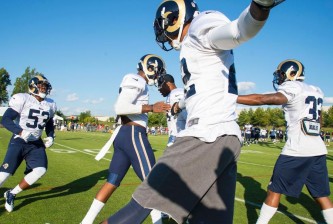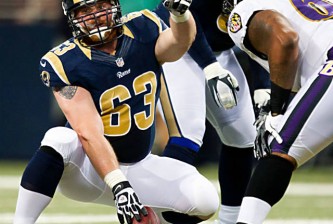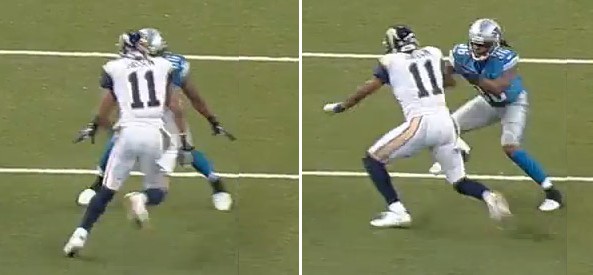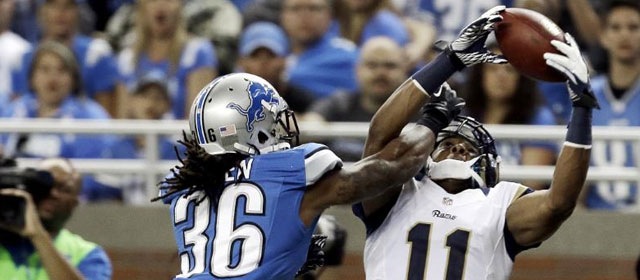
| Situation: | 2nd and 9 from the Lions 23-yardline with the game tied at 13, 9:51 remaining |
| Personnel: | 11 |
| Play: | Rag, Trey Right, Y-Orbit, Gibson on a Go-route |
| Defense: | Cover 1 man free. |
Pre-Snap:
The Rams come out in 11 personnel (1 RB, 1 TE) with two receivers split to the field. Brandon Gibson is the single-receiver to the boundary. He is working on the Lions 6th round pick, Jonte Green, who had just entered to game to replace fellow rookie Bill Bentley. Danny Amendola does an in-and-out motion typically used by the offense to read the coverage. With the cornerback following Amendola in motion and with the Lions showing blitz, it indicates that most likely the Lions will be in man coverage. As we see after the snap, the Lions are in Cover 1-man free and are bring the blitz. The Rams keep in Lance Kendricks and Steven Jackson to pick up the blitz.
After the Snap:
THE RECEIVER
There are really two keys to any go-route outside the numbers. The first key is spacing with the sidelines. The second key is winning at the line of scrimmage. With regards to spacing with the sidelines, it is important to keep in mind that the sideline is the friend of every cornerback in man coverage. A corner in man coverage will use the sideline as an extra defender by squeezing the receiver to the sideline and narrowing the window in which the quarterback fit the ball into. Conversely, it is the job of the receiver to leave himself enough space to operate and to create room for any error on the quarterback’s throw.
Gibson creates spacing with by his pre-snap alignment. He lines up about a yard away from the bottom of the numbers which is ample space for him to work. With this alignment and his technique (discussed below), it is nearly impossible for Green to squeeze him to the sidelines.
The second key is winning at the line of scrimmage. This requires great technique on the receiver’s release at the line. Off the snap of the ball, Gibson does two things very well. First, he does a very good job with the release using a technique known as foot-fire.
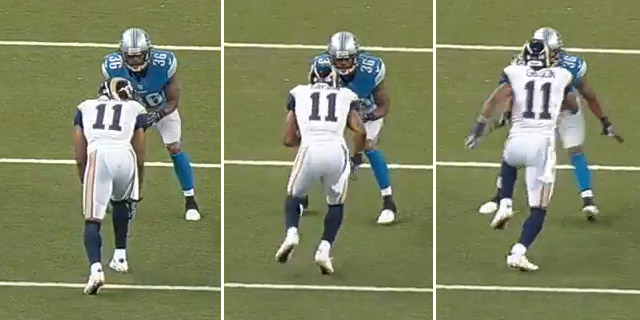
Foot-fire release is a technique that helps the receiver recognize what press technique the defender is going to use. All the receiver does is simply take his back leg and bring it even with his front leg, and begin to take small choppy steps, up field, at the defender. At this point the defender will tip his hand either by attempting to jam, bailing, or attempting to leverage the receiver either inside or outside. Gibson does a good job off the line by quickly closing the gap on Green and making Green tip his hand. Green stays square on Gibson’s initial release meaning he will now planning to run with Gibson wherever he goes (e.g. man-to-man coverage).
The second thing Gibson does well is uses a jab-step inside to flip Green’s hips.
Typically after the foot-fire release, once the receiver recognizes that the cornerback is staying square, he wants jab-step in the opposite direction of where he is going. Here, Gibson uses a quick jab-step to threaten Green inside. A cornerback left on an island has to respond to such a threat. The rookie does so accordingly. Once Gibson cuts back outside, Green has to drop his outside foot in order to run with him.
Now, the corner is no longer square and the door is open for Gibson to run his go-route. The only thing a receiver has left to do is win the race downfield, stack back over the top of the defender and catch the ball. The only thing Gibson could have maybe done better on this play was stack over the top over Green once he beats him downfield. However the quick release on the throw and the distance of the throw really doesn’t allow for Gibson to do so. Regardless, it is one of Gibson’s finer moments. A great catch in a clutch situation. It is something that has not happened often during his time with the Rams.
THE QUARTERBACK
The job is only half done now that has Gibson has successfully beat his man. Next, you need a great throw from the quarterback. And a great throw is exactly what we get.
This is one of Sam Bradford’s best throws all game. Against a single-high safety look like the Lions are in, the throw on this go-route should have some air on it. This will allow a receiver to run underneath and/or adjust to the ball. The quarterback is able to put some air on this throw because the safety, playing in the middle of the field, has a long run to get outside the numbers to defend on the throw. The quarterback wants to put this ball out front of the receiver (so that corner can’t make a play on it) and to the outside (so the safety cannot make a play on it). The window for this particular ball is pretty big, greatly due to Gibson’s spacing.
Typically after the snap, the quarterback will eye the safety just to hold him in the middle of the field long enough to prevent him from ever making a play on the ball. However, given the Rams formation and the Lions showing blitz, Bradford knows that the safety is responsible for tight end, Lance Kendricks. So, he elects to go with his best match-up and that is Brandon Gibson on a rookie corner, who just entered the game.
Result:
A great throw. A great catch. A quiet Ford Field and a 7-point 4th quarter lead on the road versus a very good team. These young Rams have to find a way to wins these types of games moving forward.
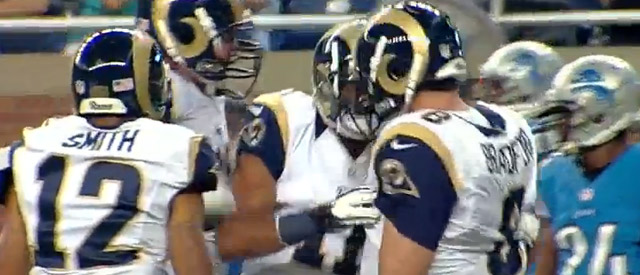
|
Definitions: Rag, Trey Right, Y-Orbit– Rag tells the running back is on the right side of the quarterback, Trey denotes that the tight end in a three-receiver set and that creates a three-receiver side, Y-orbit tells us that the Y-receiver (slot WR) has an in-and-out motion. 11 Personnel – This is just a reference to the personnel grouping the office uses. The first digit indicates how many running backs are in the game. The second digit indicates how many tight ends are in game. In this case, the Rams had one running back in the game and one tight end. Field / Boundary – This is just one way an offense and a defense measure strengths of the formation. Field refers to the wide side of the field. Boundary references the short side of the field. Since the ball is on the left hash, the field is to the right. Cover 1 Man Free- A type of coverage where the cornerbacks are man-to-man and the safety is plays in a deep hole in the middle of the field. Depth is the safety’s friend. Depth on the play allows him to cover deep balls on both side of the field and also allows him to keep the play in front of him. Single-high safety- This is a pre-snap read of how many safeties a defense will use on a given play. The number of safeties sometimes will indicate what kind of coverage the offense will see on a give play. |





















